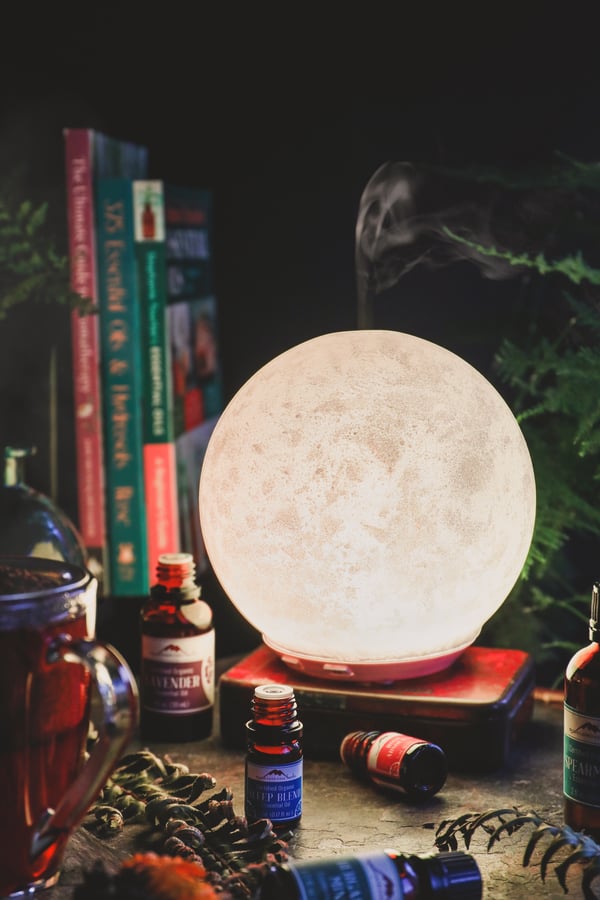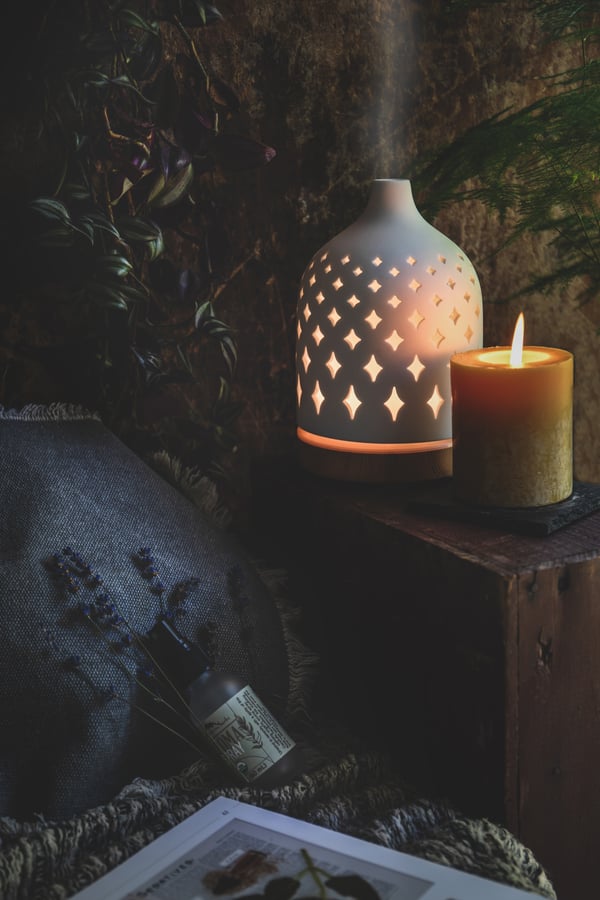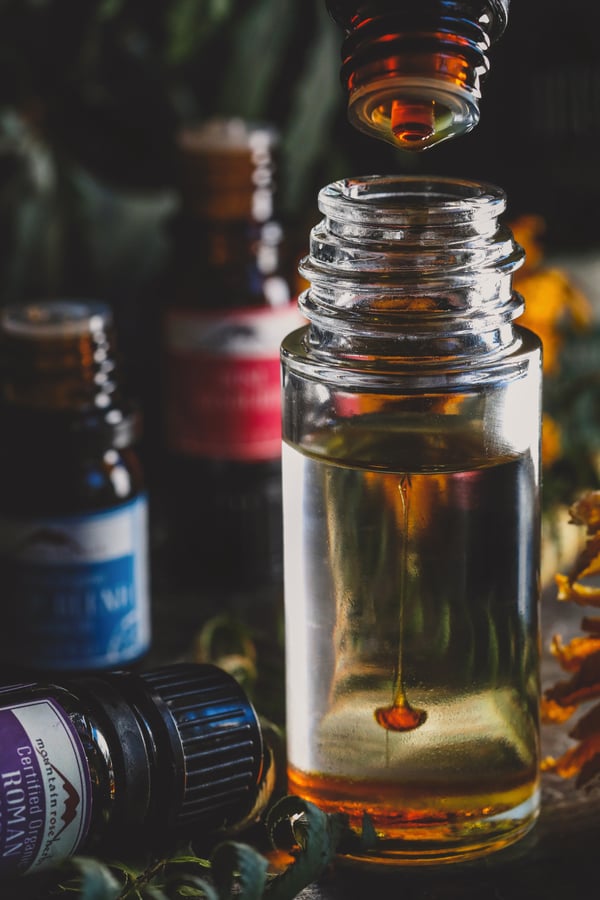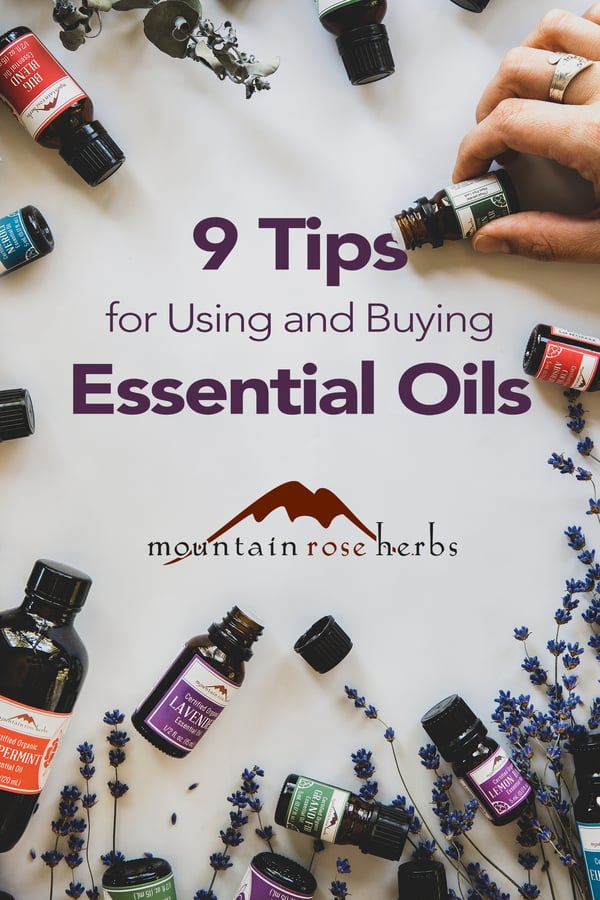In November of 2021, Mountain Rose Herbs opened our first Aroma Bar, an essential oil marketplace right here in our hometown of Eugene. The Aroma Bar is designed to engage the senses as people explore the art and science of pure, natural aromatherapy. This boutique shop offers high-quality, ethically sourced essential oils and personal aromatherapy products to provide you with the resources you need to harness the powerful potential of scent in your personal journey. No surprise, our new venture means we are getting a lot of questions from people who are beginning to explore essential oils and aromatherapy as part of their personal wellness plan. With that in mind, I want to share eight of the most frequently asked questions and some of my favorite tips for using and storing essential oils.
#1: WHAT IS AN ESSENTIAL OIL?
First, let's define what an essential oil is and how it's made. Essential oils are the volatile aromatic oils produced by plants. Plants create resins and oils to attract pollinators, warn predators, and to protect themselves against disease. The extraction called "essential oil" is this aromatic substance concentrated through various methods. Imagine fresh lemon balm leaves warming in the sun, rosemary rubbed between the palms of your hands, or bringing lavender flowers to your nose for a deep inhale.
An essential oil is not an infused herbal oil; this is a very common misconception. Below you will learn the different methods used to create essential oils.
#2 HOW ARE ESSENTIAL OILS EXTRACTED?
-
Distillation
Most plant aromatics can be captured through vaporization. Depending on the botanical, distillation can be done using only steam, utilizing water and steam, or by fully submerging the plant material in water. We’ve created an infographic to illustrate the distillation process. You will find that most essential oils are produced this way, including flowers, leaves, barks, and roots. Examples include: lavender, ylang ylang, peppermint, eucalyptus, fir needle, valerian, rose, and sandalwood.
-
Cold Pressed
Some oils, specifically citrus peel, are cold pressed to extract their aromatics. This process involves puncturing the skins of either the whole fruit or just the fruit peel and pressing the essential oil out. With this process, a little bit of juice is extracted, which is then separated from the oil. You can find distilled citrus peel oils on the market. However, these are mainly used in the fragrance and flavoring industry and are not appropriate for aromatherapeutic use. Examples include: orange, grapefruit, tangerine, lime peel, and lemon.
-
Solvent Extracted
Some plant aromatics are too delicate for distillation, too bound up in resin, or not water-soluble so a solvent is used to make an extraction. The solvents used can be a range of substances including hexane, alcohol, acetone, propane, and others. That puts the power in your hands to decide if it's the right ingredient for your needs. In a good quality absolute, the solvent should be completely evaporated out of the finished product. However, because of the possibility of trace amounts of solvent, absolutes are not recommended for aromatherapeutic purposes, but are great for perfumery projects and are alcohol soluble. Examples include: jasmine, vanilla, oak moss, oakwood, rose absolute, and benzoin resin.
#3: HOW CAN I FIND HIGH QUALITY ESSENTIAL OILS?
- You want to be sure that the essential oils are pure aromatic plant oils without diluents. Some essential oils on the market are cut with a carrier or diluted with lesser quality products.
- Next, to be certain that you are purchasing the right ingredient, look for the botanical name on the product label. For example, Peppermint (Mentha piperita), should be listed clearly.
- Purchase oils that are certified organic or sourced from a supplier you trust. Because essential oils are so concentrated, that means that water-soluble pesticides and other toxins can be concentrated in the oil as well. Keep in mind that some essential oils are made from wild-harvested plants, so they may lack organic certification.
- Avoid buying anything with the term “Fragrance Oil” as these are often synthetically produced and are not true botanical essential oils.
#4: WHAT IS A THERAPEUTIC GRADE ESSENTIAL OIL?
When first starting out, many beginning aromatherapy enthusiasts look for oils that are “therapeutic grade.” This distinction, however, is not an industry standard and is not endorsed or regulated by any governing agency. It is purely a marketing claim. You can learn more about this issue by visiting: AromaWeb and the National Association for Holistic Aromatherapy.
#5: TIPS FOR BUYING AND STORING ESSENTIAL OILS
- Always research the plant part and production method used. Sometimes you will find several different options for one plant, for instance cinnamon leaf and cinnamon bark or dry ginger and fresh ginger. These will offer very different properties and aromas to your creation. Similarly, there are three different oils that are created from Citrus aurantium or the bitter orange tree.
- Purchase small amounts to start. One drop of essential oil goes a very long way, so a 1/2 oz. or 1 oz. bottle will last quite a while. Plus, essential oils can be pricey, so it's nice to experiment and discover which ones you use most often before purchasing large amounts.
- Dark colored glass, like amber bottles, is the way to go. Store your essential oils in a cool, dark cabinet away from heat and light.
- Don’t store with the glass and rubber-top dropper in the bottle. Essential oils are concentrated and can break down the rubber over time. Always remove the glass dropper and use the screw cap. The drop-by-drop reducers that come in small bottles are fine and do not need to be removed.
- Visit our Essential Oil Storage Tips for Maximizing Shelf Life for more storage tips.
#6: ARE ESSENTIAL OILS SAFE?
Well...yes and no. We like to say that less is best and use with care!
These highly concentrated aromatics enter through our olfactory system and the skin, leading directly to the brain and our bloodstream. This allows the plant properties to cause changes both emotionally and physiologically within our bodies. Great, right? Yes, but, essential oils also have to be detoxed by our liver and kidneys, and some plant aromatics are hard to process. Even using larger amounts of "safe" essential oils can be harmful to certain populations like children, the elderly, people with compromised liver or kidney health, animals, and pregnant women. We highly recommend seeking the guidance of a qualified healthcare practitioner in these cases. And it is imperative that you research an oil’s properties before use to make sure it isn't contraindicated for your health.
#7: WHAT IS A SAFE WAY TO USE ESSENTIAL OILS TOPICALLY?
There are endless ways to use essential oils topically:
- You should always dilute essential oils with a carrier of some kind. This can be organic vegetable oil, hydrosol, witch hazel extract, or alcohol. To learn more about diluting essential oils, see our Essential Oil Conversion Chart, Calculator, & Pro Tips
- 1% Dilution: 5-6 drops per ounce of carrier is appropriate for preparations such as massage, where a generous amount is being used on the skin.
- 2% Dilution: 10-12 drops per ounce of carrier is appropriate for aromatherapy applications and body or personal care recipes.
- Any time you are working with a new essential oil and want to make a topcial recipe, do a patch test to make sure you won't have a reaction and the oil is right for you.
- Always avoid mucous membranes like the eyes and mouth unless you are under the care of a certified practitioner. These oils can be very caustic and can cause serious chemical burns.
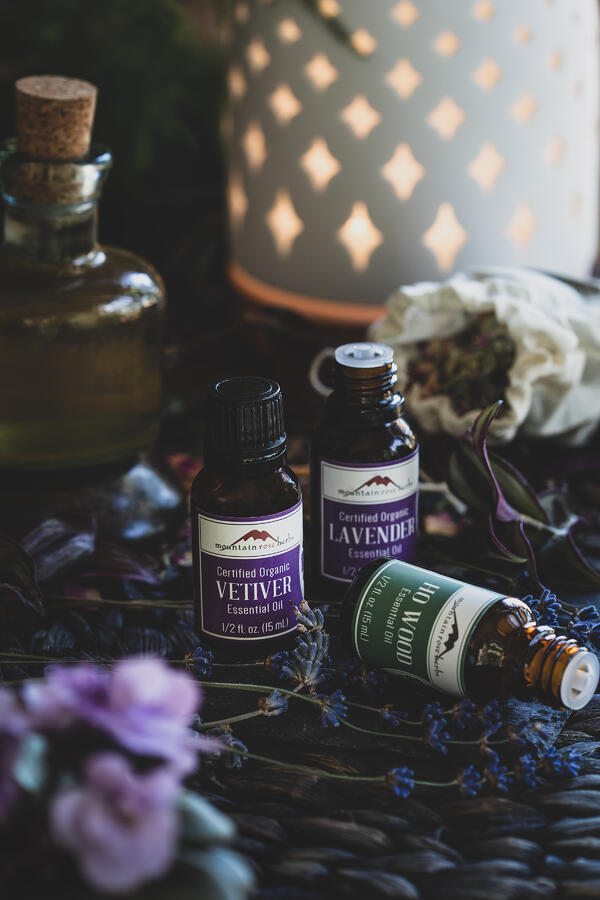
#8: SHOULD I USE ESSENTIAL OILS INTERNALLY?
There is so much misinformation out there about whether or not essential oils are safe to use internally. We, along with the international aromatherapy community, believe that you should never use essential oils internally without the guidance of a qualified, certified healthcare practitioner. Essential oils can be incredibly caustic, causing burns and irritating the mucous lining of your digestive tract.
Stronger is not always better or more helpful. Remember, aromatics must be detoxed by the liver and kidneys. Unlike essential oils, herbal preparations are very effective when used internally as gentle support for your body's own natural healing processes and are a very appropriate method of taking aromatics internally. For instance, one cup of peppermint tea or some fresh squeezed lemon juice are strong remedies.
If you are looking for something a bit more potent than tea, tinctures are a great option for internal use.
#9: WHAT KIND OF RECIPES CAN I MAKE USING ESSENTIAL OILS?
Essential oils can be used in many different ways, from natural body care formulas, to diffusing for aromatherapy and inhalations, to natural perfumery, body sprays, massage oils, cleaning products, and much more, these versatile plant ingredients offer so many possibilities.
wANT TO DO MORE SELF STUDY ON ESSENTIAL OILS?
EXPLORE OUR FAVORITE AROMATHERAPY BOOKS!
You may also enjoy:
How to Create Your Own Essential Oil Blends
5 Essential Oil Guides for Aromatherapy Explorers
9 Best Essential oils for Stress Relief

